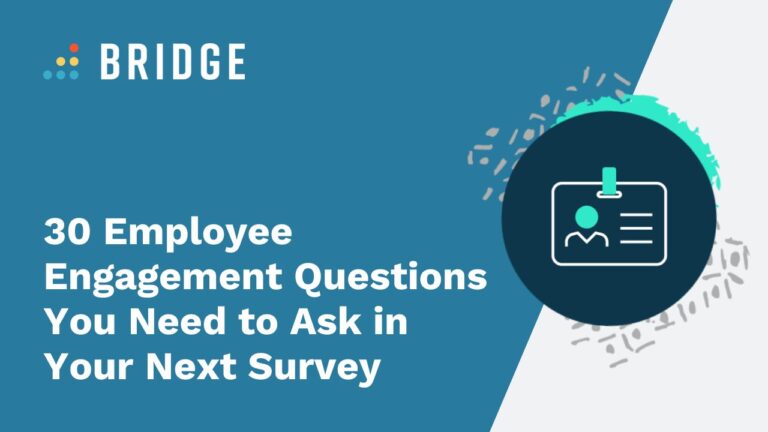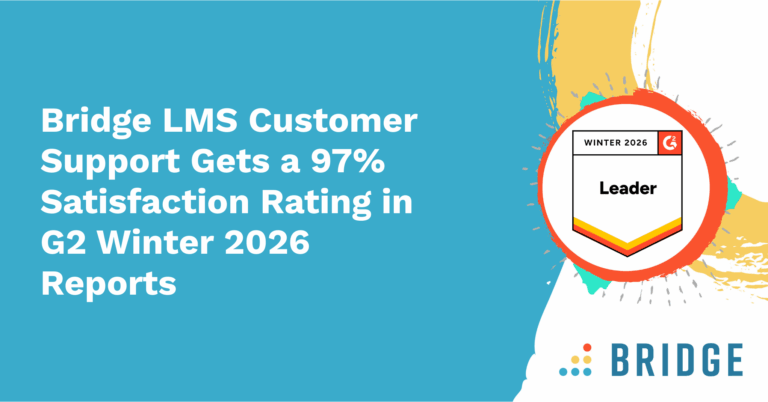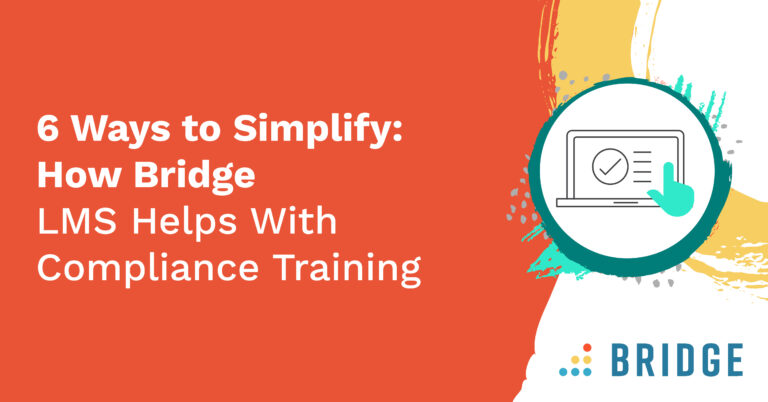Measuring and driving employee engagement is becoming a top strategic priority for organizations.
As the findings from a CIPD report show, leaders are increasingly looking to non-financial people metrics to evaluate performance, and nearly 60% believe that employee engagement surveys are a powerful performance indicator.
To monitor the pulse of your workforce, engagement surveys need to be crafted thoughtfully and with intention, allowing you to listen and enact change across all areas of the organization.
Ask the Questions That Identify and Measure the Drivers of Employee Engagement
Driving employee engagement takes more than just an annual survey that recycles the same questions year after year. In order to capture valuable and in-depth data, you need to go beyond surface-level sentiments and ask questions that reveal how people feel about key areas of the employee experience aligned with organizational priorities.
This way, your questions will capture the collective voice of employees and provide a real-time snapshot of what they most value.
Aim to include a mix of question formats in your surveys. This will help to build a more rounded view of engagement and provide additional insight, including the following:
- Open-ended questions that allow for more detailed responses and feedback, additional context, and deeper insight
- Straightforward five-point numeric or Likert scale rankings that provide a range of responses and measure sentiment
- Closed-ended questions with “yes/no” or “agree/disagree” responses that elicit clear-cut responses and are easy to interpret and analyze
By continuously collecting and analyzing results, it’s easy to translate this feedback into a set of actionable next steps.
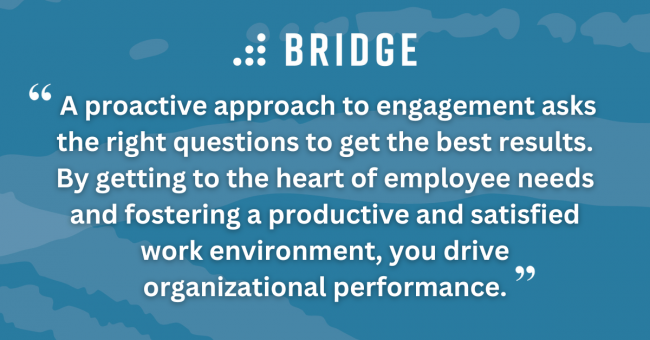
30 Questions to Include in Your Next Engagement Survey
A proactive approach to engagement asks the right questions to get the best results. By getting to the heart of employee needs and fostering a productive and satisfied work environment, you drive organizational performance.
Consider these 30 questions about different aspects of the employee experience:
1) Access to Performance Feedback and Recognition
A culture of recognition and positive feedback sends a clear message to your people that their hard work is recognized and their development is appreciated and actively encouraged.
Asking questions about feedback and recognition is an effective way to find out whether people are satisfied with the frequency of performance reviews. Recognition should be a regular occurance, and feedback should always empower people to develop and grow.
It's not just managers and leaders who should call out outstanding work—peer feedback is also an effective way to drive motivation and strengthen engagement within your organization.
Questions to include in your engagement survey:
- To what extent do you agree with the following statement: “I have regular performance conversations with my manager.”
- Have you received positive recognition for good work in the last seven days?
- To what extent do you agree with the following: “I receive the feedback and coaching I need to help me develop and grow.”
- How would you like to be rewarded and recognized?
- How would you rate the current performance review process?
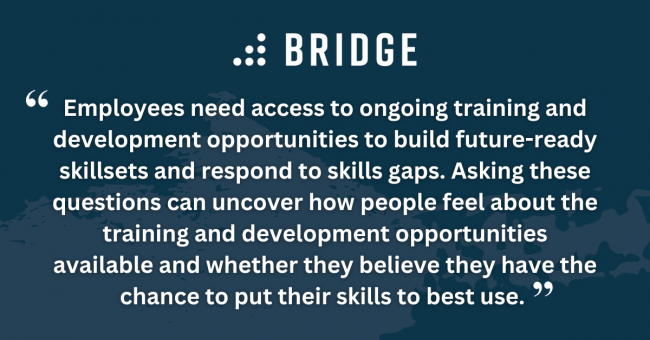
RELATED READING | ‘4 Reasons to Implement Continuous Feedback (And a Few Tips on Making It Happen!)’
2) Professional Growth and Skills Development Opportunities
According to PwC's Global Workforce Hopes and Fears Survey, business leaders see the need for reskilling and upskilling in response to disruption and change. However, only 43% of employees have a clear sense of the skills needed for their jobs in the coming years.
Employees need access to ongoing training and development opportunities to build future-ready skillsets and respond to skills gaps. It's not enough to simply roll out organization-wide development programs—your people must also understand the value of what they're learning and how to apply it.
Including these questions in surveys can uncover how people feel about the training and development opportunities available and whether they believe they have the chance to put their skills to best use. It's also good to check that training aligns with their personal career goals and whether they're aware of all of the development and advancement opportunities available to them.
Questions to include in your engagement survey:
6. To what extent do you agree with the statement: “There is someone at work who encourages my development.”
7. Have you discussed your career development within the past six months?
8. How satisfied are you with the learning and development opportunities available to you?
9. To what extent do you agree with the statement: “I have access to all of the resources I need to advance and grow.”
10. What skills would you like the opportunity to develop?
RELATED READING | ‘4 Reasons to Implement Continuous Feedback (And a Few Tips on Making It Happen!)’
3) The Perceptions of Managers and Leaders
Employees want a manager who supports them and communicates openly. Deloitte's Wellbeing at Work survey backs this up, and findings reveal that 94% of employees believe their managers should have at least some part in supporting them. What's more, 96% of managers agree.
Ask questions that uncover how your people feel about the human qualities of management and leadership, such as communication, empathy, and trust. The behaviors and attitudes displayed by leaders, such as how they respond to change and share decisions and strategies, can significantly impact employee engagement and sentiment.
Questions to include in an engagement survey:
11. How would you rate the level of communication from leaders?
12. To what extent do you believe leaders contribute to a positive work culture?
13. To what extent do you agree with the statement: “My manager regularly keeps me informed about company initiatives and priorities.”
14. Are you satisfied with the support you receive from your manager?
15. To what extent do you agree with the following: “I have trust and confidence in leaders to do what is right.”
TIPS TO ENGAGE EMPLOYEES IN CONVERSATION | ‘4 Ways to Create a Culture of Conversation for Your Organization’
4) Employee Wellbeing and Satisfaction
A productive and thriving culture is one where your people all feel a sense of belonging, purpose, and care about their work.
As Gallup finds, being treated unfairly at work is a leading cause of employee burnout and poor wellbeing, leading to higher levels of quiet quitting.
Your engagement survey can show how people feel about the organizational culture, and how safe and valued they feel in the workplace. People should feel safe to learn from their mistakes, voice their opinions, and reach out for support.
Questions to include in your engagement survey:
16. If you could change one thing about your workplace, what would it be?
17. To what extent do you agree with the statement: “I feel comfortable contributing my ideas and opinions.”
18. How would you rate your job satisfaction?
19. Do you believe that your job gives you the flexibility to meet the demands of your personal life?
20. Would you recommend your company as a place to work?
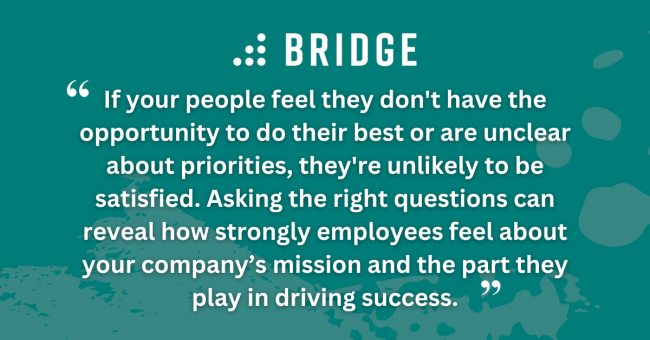
RELATED READING | ‘6 Simple Ways to Prevent Quiet Quitting and Drive Employee Engagement’
5) Shared Expectations and Alignment With Goals
If your people feel they don't have the opportunity to do their best or are unclear about priorities, they're unlikely to be satisfied. Asking the right questions can reveal how strongly employees feel about your company’s mission and the part they play in driving success.
Setting and tracking goals sets clear expectations with your people and helps them perform at their best. Employees should always know what's expected of them and how their job feeds into team and organizational goals. A strong sense of ownership over their goals and close alignment with the organization's mission and purpose can empower your people in their work.
Similarly, check that your people have all the tools required to do their best and that no roadblocks are getting in the way of their work.
Questions to include in your engagement survey:
21. Are organizational initiatives clearly communicated to you?
22. To what extent do you agree with the statement: “I know how my work supports my team and the wider organization.”
23. Does the organization’s mission and purpose make you feel that your work is important?
24. To what extent do you agree with the statement: “I feel confident that I can meet my goals and objectives.”
25. Do you have access to the resources and tools you need to perform at your best?
CHECK OUT THESE ENGAGEMENT BEST PRACTICES | ‘3 Employee Engagement Ideas for Remote Workers’
6) Collaboration and Relationships With Peers
The team dynamic can have a massive impact on engagement and morale. Building trust and supporting each other to succeed creates great results within your organization.
Collaboration and happiness should be a priority within team dynamics and the wider business. Ask questions that measure how confident people feel in the abilities of teammates and whether they have the opportunity to learn from one another.
Encouraging peer feedback and skills development can help to strengthen collaboration between employees and lead to a culture of knowledge sharing. When people feel inspired to develop together and see others as a source of knowledge, it can foster relationships and encourage growth.
Questions to include in your engagement survey:
26. How would you rate your relationship with your coworkers?
27. Do you know who to ask for help when unexpected situations arise?
28. To what extent do you agree with the following: My team inspires me to perform at my best.”
29. Do you have opportunities to collaborate and work with your team regularly?
30. In the last month, have you had opportunities to connect with peers outside your team and department?
FURTHER READING | ‘How Can Smart Stay Interview Question Selections Boost Employee Retention?’
Create Engaging L&D Experiences With Bridge
An engaged workforce is the key to organizational success, and one of the most dependable ways to achieve engagement is to put learning and development at the heart of your culture.
Bridge is a learning and performance platform that connects your employees with development opportunities. Bridge gives you the tools to design and deliver engaging training to your employees, teach them new skills, and align goals to strategic objectives.
